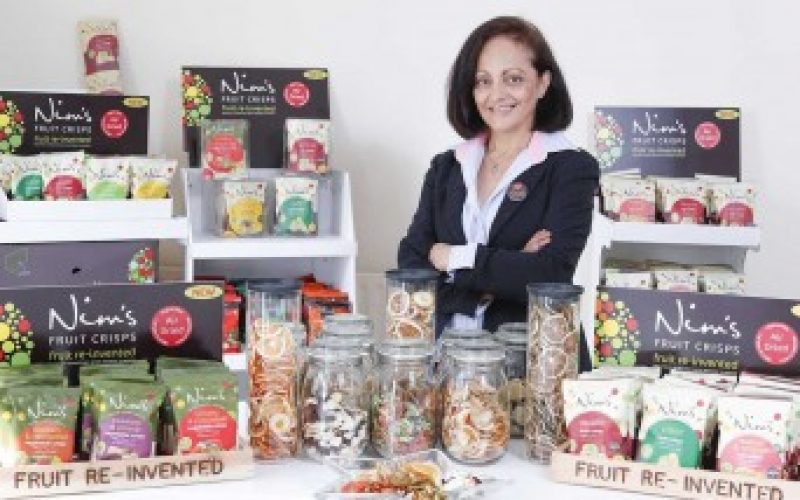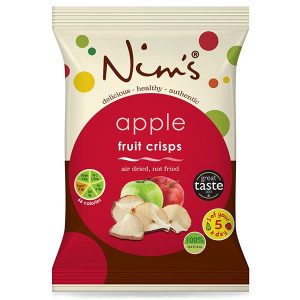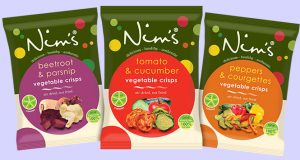
When I spoke to Nimisha Raja founder of Nim’s Fruit & Veg Crisps she’d been testing a new pineapple product. She told me “I’m constantly developing new products, improving existing ones and at the same time I have to make it all cost-effective”
Nimisha is what I’d describe as a true innovator. She spots an opportunity and she just goes for it. She used to own a coffee shop and she recalled how when parents and children came in it was always a battle. A battle between the children wanting crisps and the parents wanting their children to eat something healthy. It was exhausting for the parents, the children and the customers enjoying a quiet coffee!
One day she came across freeze-dried apple pieces and bingo! the idea for fruit & veg crisps; a healthy snack that children wanted to eat and parents wanted to buy was born. She bought some equipment, made a make-shift kitchen in her garage and got to work to develop the product. She worked evenings and weekends developing a healthy product, that tasted good, only used natural ingredients and was nutritious
‘Thankfully I was completely ignorant about what I was letting myself in for”
 Nimisha called her product Nim’s and she experimented for nine months with painstaking attention to detail to get the product right. This also included the branding. “It’s so important that the packaging looks good. I’m used to running shops and buying goods so I’m very aware of how a product has to look to sell.
Nimisha called her product Nim’s and she experimented for nine months with painstaking attention to detail to get the product right. This also included the branding. “It’s so important that the packaging looks good. I’m used to running shops and buying goods so I’m very aware of how a product has to look to sell.
“I wanted people to see Nim’s on the front of a pack and not have to look at the back for the list of ingredients – they would know it would be 100% natural”
Test your product with your customers
Finally after endless sleepless nights Nimisha was happy. She tested whether the product would sell in her own coffee shop. It did. Next she tested selling her crisps at a stall at a local summer fair. She got good feedback. She then developed some trays with branded backing that she took to the local delis and independent shops that might sell them. She offered the tray of crisps on a sale or return basis to see if there was a market. 16 out of 20 shops she approached said ‘yes’. She also wanted to test for repeat business potential.
“People might try a one-off as a novelty, so if the shop could refill their tray x3 then that’s repeat business and then I knew the product has potential”
12 of the 16 shops sold more than 3 trays.
To be sustainable Nimisha needed volume
Nimisha knew from the beginning that being a niche supplier to small independent shops was not going to move her business forward. If her business was going to work then it had to be at volume. But it is hard to make the shift when customers like your products. It can be easy to lose your business mind when you are so close to and passionate about your product.
It took a friend to point out to Nimisha that selling a few hundred bags here and there wasn’t sustainable, financially or personally as she was working all hours of the day and night.
She shifted her focus from how to supply to small shops to how to scale. She started researching suitable factories that had equipment that could be adapted to make Nim’s fruit crisps. She looked at factories that already dried fruit in Bulgaria, Poland and Turkey. Finally she decided to test the approach with a factory in Hungary whose owner loved the product. He didn’t speak a word of English though so his daughter drove for half a day for the meeting to translate for him!
Nimisha spent a lot of time showing the factory how to make the crisps. The logistics of getting the product from Hungary to the UK were also far more complex and expensive than she imagined.
By this time Nim’s crisps were in Harrods, Selfridges, Planet Organic and 3 national distributors which might sound big but it was not the volume needed to make adequate margins. In addition to that Nimisha didn’t feel in control. There were problems with the quality. They were on the brink of signing up major supermarkets but they were also getting complaints. Scaling when manufacture wasn’t right was a recipe for disaster so Nimisha decided to open her own factory.
Nimisha secured an investor, sold her house and her coffee shop and set up a factory from scratch. Her investor said “I’m investing in you – I don’t know anything about the product but if anyone can make it work you can”
Before going big Nimisha had to get the product right
With renewed massive pressure to succeed (as if there wasn’t enough already) and a 10,000 square foot factory in Kent, Nimisha spent 6 months making products and learning to use the machines. In this time not a single fruit crisp was sold. They couldn’t sell to supermarkets until they got the product right.
Nim’s crisps stopped trading for a total of 18 months. When they closed no one else made fruit and veg crisps. When the factory opened in November 2015 the market had changed and there was competition.

However, despite another company now manufacturing fruit crisps albeit fried and made in China, once Nim’s was back in the market their biggest challenge wasn’t the competition, it was that people didn’t understand the concept of a fruit crisp. They thought they were some sort of fruity flavoured snack.
“There is a big challenge in getting people to understand what it is – it takes a long time for people to understand something new.”
In June 2016 Nim’s joined a programme with Produced in Kent – a trade organisation supporting food businesses in Kent. Just 3 months after opening the factory they hosted a stand at a food trade show in Belgium. The response was tremendous. They are now selling to overseas markets as well as starting to gain traction with big UK supermarkets including Co-op and Ocado. Their challenge now is maintaining a high quality product while managing the increased demand.
“I want my crisps to be an everyday product. It’s 1 of our 5 a day. The cost has to be comparable to a packet of crisps – health shouldn’t be expensive and I can only achieve that price point with scale”
Nimisha’s advice for anyone wanting to innovate is
- Make sure there is a market for your product.
- Don’t make something so innovative that it’s too hard for someone to understand.
- There is lots of help and investment for funding for innovation if you seek it out.
- Understand that it will take time and money to develop your idea and then more to make it commercial.
- Anyone can copy you. Be prepared for this and protect yourself where possible.
- You know more than you think you know.
- Follow your instinct and have belief. “I wouldn’t have started if I didn’t think it had potential.”
- Don’t dawdle and waste time – just get on with it.
- Don’t be afraid to ask for help.
- Just because you can’t do it now doesn’t mean that you can’t learn.
If you’d like to learn more insights from other successful innovators check out the new Innovation Leadership Launchpad – a mix of case stories and practical tips to help you innovate. Order your free copy straight into your inbox today.
